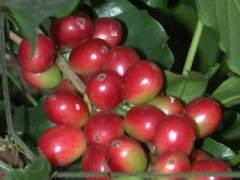The world's three largest coffee BlueMountainCoffee Blue Mountain coffee beans

BlueMountainCoffee (Blue Mountain Coffee)
It is a well-known coffee produced only in the Blue Mountain region of Jamaica in Central America, and only coffee grown in the Blue Mountain area above 1800 meters can be authorized to use the logo "Jamaican Blue Mountain Coffee (BlueMountainCoffee)," accounting for 15% of Jamaica's total Blue Mountain Coffee production. Coffee grown between 457m and 1524 m above sea level is called alpine coffee, and coffee grown between 274m and 457m above sea level is called Jamaican coffee. Blue Mountain Coffee has mellow, bitter slightly sweet, soft and smooth characteristics, and slightly sour taste, can make the taste more sensitive, taste its unique taste, is the best of coffee.
CubitaCubitaCoffee (amber coffee)
Cubita coffee also has a high reputation in the coffee industry. Cuban Crystal Mountain Coffee ranks first in the world. Crystal Mountain is adjacent to the Blue Mountain Mountains of Jamaica, and its climatic conditions are similar to those of Jamaican Blue Mountain Coffee. Cubita adheres to the principle of perfect coffee, only making individual coffee, picking coffee beans by hand, plus washing coffee beans to ensure the quality of coffee. Cubirta is like an elegant princess, with the characteristics of nobility, tenderness and grace. The balance is excellent, the bitter taste and the sour taste are well matched, and there will be a delicate, smooth, fresh and elegant feeling in the taste. The designated coffee at the Cuban embassy is called the unique Caribbean flavor coffee.
KopiLuwakKopiLuwak (Kopi Luwak)
Is a recently invented coffee, produced in Indonesia, coffee beans are one of the civets' food range, but the coffee beans cannot be completely digested by the digestive system. The coffee beans are fermented in the civets' intestines and stomach and excreted by feces. The local people take out the coffee beans from the civet feces and then do the processing, that is, the so-called "cat shit" coffee, this coffee has a unique taste and different taste. However, people who are used to this taste will never forget it for a lifetime. Due to the gradual deterioration of the wild environment, the number of civets is also slowly decreasing, resulting in a very limited output of this kind of coffee. People who can taste this coffee are very lucky.
Important Notice :
前街咖啡 FrontStreet Coffee has moved to new addredd:
FrontStreet Coffee Address: 315,Donghua East Road,GuangZhou
Tel:020 38364473
- Prev

Took some pictures of coffee fruits to share.
I took some pictures of coffee fruits. Share it.
- Next

What is the difference between authentic Italian beans and domestic beans?
Generally speaking, coffee looks the same after being fried, but do you know that there are actually dozens of different coffee beans? But when they come to your daily consumption, there are only two kinds of coffee that are really useful, one is Arabica, and the other is Robusta, which has evolved into the two main types of coffee we use. What's the difference between the two? It's very big, and knowing them is very helpful for choice.
Related
- Guji coffee producing area of Guji, Ethiopia: Humbela, Shakiso, Wulaga
- What is the most expensive variety of Qiloso in BOP multi-variety group?
- How to store the coffee beans bought home?
- Why are Yemeni coffee beans so rare now?
- Ethiopian Sidamo all Red Fruit Sun Sun Santa Vini Coffee beans
- SOE is mostly sour? What does it mean? Is it a single bean? what's the difference between it and Italian blending?
- Is Italian coffee beans suitable for making hand-brewed coffee?
- How to choose coffee beans when making cold coffee? What kind of coffee beans are suitable for making cold coffee?
- Just entered the pit to make coffee, what kind of coffee beans should be chosen?
- Can only Japan buy real Blue Mountain Coffee? What are authentic Jamaican Blue Mountain coffee beans?

